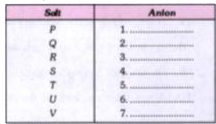Explain the following facts:
(a). Copper hydroxide is soluble in ammonium hydroxide but not in sodium hydeoxide.
(b). Addition of an alkali to cuprous chloride solution gives a yellow precipitate which gradually changes to a red colour.
This is becaue Cu2+ can form many conplexes with NH⊕4 which are soluble in water.
(b). Cu2Cl2+2NaOH→Cu2O↓+2NaCl+H2O
The precipitate changes colour from yellow to red due to formation of Cu2O.
Topper's Solved these Questions
- D AND F BLOCK ELEMENTSBook:CENGAGE CHEMISTRY ENGLISHChapter:D AND F BLOCK ELEMENTSExercise:Solved Example
Explore 18 Videos
- D AND F BLOCK ELEMENTSBook:CENGAGE CHEMISTRY ENGLISHChapter:D AND F BLOCK ELEMENTSExercise:Ex 6.1 Subjective
Explore 12 Videos
- COORDINATION COMPOUNDSBook:CENGAGE CHEMISTRY ENGLISHChapter:COORDINATION COMPOUNDSExercise:Archives Subjective
Explore 18 Videos
- ELECTROCHEMISTRYBook:CENGAGE CHEMISTRY ENGLISHChapter:ELECTROCHEMISTRYExercise:Archieves Subjective
Explore 35 Videos
Similar Questions
Explain the following:
(i). Copper hydroxide is soluble in ammonium hydroxide but not in sodium hydroxide.
(ii). A dark blue precipitate is formed when sodium hydroxide solution is added to copper sulphate solution. The precipitate darkens on heating.
View SolutionWhich of the following hydroxides is an alkali?
a) ammonium hydroxide
b) calcium hydroxide
c) copper hydroxide
d) sodium hyroxide.
View Solution
Knowledge Check
A chloride which forms a precipitate that is soluble in excess of ammonium hydroxide is :
ACalcium chlorideBFerrous chlorideCFerric chlorideDCopper chloride
Solution A is a sodium hydroxide solution Solution B is a weak acid. Solution C is dilute sulphuric acid. Which solution will
give a white precipitate with zinc sulphate solution ?
View SolutionSalts P, Q,R,S,T,U and V undergo reactions (i) to (vii) respectively. Identify the cation present in these salts on the basis of these reactions. Tabulate your answer in the formate given below.
(i) When the salt Pis heated with sodium hydroxide solution a vigorous reaction takes place and a colourless gas is evolved with a pungent and suffocating smell that brings tears in our eyes. The evolved gas gives dense white fumes with a moist glass rod depped with hydrochloric acid.
(ii) Addition of sodium hydroxide solution to a solution of salt Q gives a thick white precipitae which is soluble in excess of sodium hydroxide solution to form a clear solution.
(iii) Addition of ammonium hydroxide solution to a solution of salt R gives a dark blue precipitate which is soluble is excess of ammonium hydroxide solution to form an intense deep blue solution.
(iv) Addition of ammonium hydroxide solution to a solution of 5 gives a dirty green [bottle green] precipitate which is insoluble even in the excess of ammonium hydroxide solution.
(v) Addition of ammonium hydroxide solution to a solution of T gives a reddish brown (rust precipitate] precipitate which is insoluble even in the excess of ammonium hydroxide solution.
(vi) Addition of ammonium hydroxide solution to a solution of V gives a geletaneous white precipitate which is soluble in excess of ammonium hydroxide solution to form a clear solution.
(vii) Addition of ammonium hydroxide solution to a solution of V gives no precipitate but it gives a chalky white precipitate with sodium hydroxide solution which is insoluble even in the excess of sodium hydroxide solution.

View SolutionAnswer the following question :
How will you distinguish between Ammonium hydroxide and Sodium hydroxide using copper sulphate solution?
View SolutionIdentify the cation in each of the following case
Ammonium hydroxide solution when added to the solution B gives white precipitate which dissolves in excess
View SolutionIdentify the cation in each of the following case
Sodium hydroxide solution when added to the solution 'A' gives reddish brown precipitate.
View SolutionIdentify the cation in each of the following case
Ammonium hydroxide solution when added to solution D gives dirty green precipitate which changes to reddish brown after some time.
View SolutionIdentify the cation in each of the following case
Ammonium hydroxide solution when added to the solution gives bluish white precipitate which dissolves in excess to give deep blue solution.
View Solution
